Japan
Wood Products Prices
Dollar Exchange Rates of 25th
January 2017
Japan Yen 113.80
Reports From Japan
Exports at 15 month high
Data from the Ministry of Finance shows Japan's exports
rose in December marking the first increase in 15 months.
The export performance was boosted by strong sales of
electrical components and car parts, a positive sign for the
export-dependent economy but protectionism in the US
could undermine further growth in exports.
Exports to China, Japan's top trading partner, expanded
12.5% year-on-year and exports to the US, the second
largest trading partner, rose 1.3 per cent year-on-year, the
first increase in 10 months. On the other hand exports to
the EU fell in December.
For more see: http://www.customs.go.jp/toukei/shinbun/tradest_
e/2016/2016124e.pdf
Talking down the dollar
After a good start to the year when the yen/dollar
exchange rate was around 116 yen to the dollar, towards
month-end the dollar weakened pushing the yen to 112 on
25 January, disappointing news for exporters and the Bank
of Japan.
The dollar fell mainly in response to warnings from the
US President that the dollar was too strong and that this
hurt the competitiveness of American companies.
During the World Economic Forum in Switzerland an
adviser to the US President also warned of the risk of a
strong dollar to the U.S. economy.
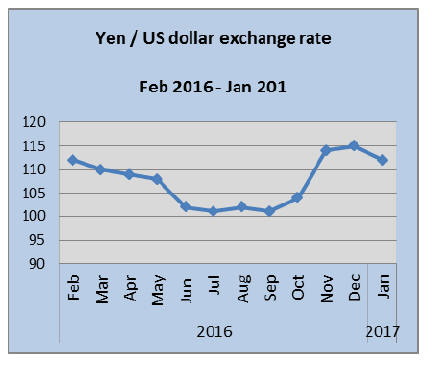
Bank of Japan concerned on housing oversupply
With home rents falling in Japan on a surge in
construction of apartments, the Bank of Japan now faces
yet another obstacle as it seeks to lift inflation.
In its regional economic report for January, the Bank of
Japan (BoJ) reported on the impact of investment in
housing and knock-on on demand for durable goods and
the conclusions were very sobering. In many cities and
even in Tokyo demand for rental properties was seen as
weakening due to an oversupply of properties.
The BoJ has expressed concern on the current
direction of
the housing market however, US interest rates are set to
rise further and this may give the BoJ an opportunity to
move away from its negative interest rate policy.
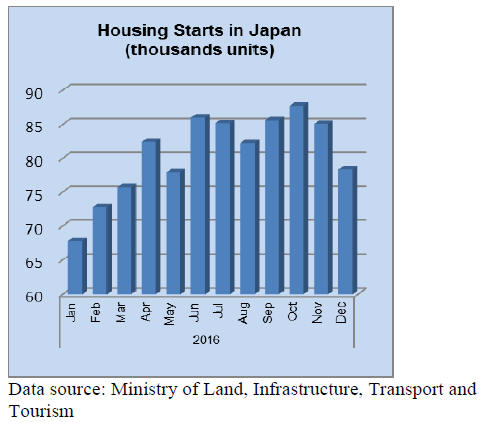
Japan¡¯s wooden furniture imports
In October 2016, for the first time since February of the
same year, Japan¡¯s bedroom furniture imports reversed the
8 month downward spiral. October 2016 bedroom
furniture imports rose around 1% from September levels
but were still some 34% down from the peak in February.
In contrast, kitchen furniture imports, while much smaller
than bedroom furniture imports continued at around the
same level as seen four months ago. Given that both
bedroom and kitchen furniture imports are influenced by
the housing market the difference in import trend is hard
to explain.
One possible explanation could be that imports of kitchen
furniture reflect the growth in renovations rather than new
home building and in the new housing market home
buyers are putting off non-essential purchases of moveable
furniture.
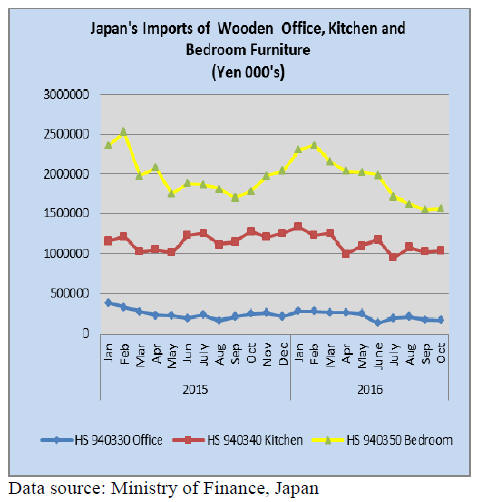
Office furniture imports (HS 940330)
Year-on-year, October imports of wooden office furniture
were down 31.5% and down 2.5% from levels in
September.
In October the top three suppliers accounted for over 83%
of all Japan¡¯s wooden office furniture imports and all
achieved increases in sales. China, the top supplier, saw its
share of all wooden office furniture imports rise to 66%.
The second and third ranked suppliers were Taiwan P.o.C
and Portugal which accounted for 9% and 8% respectively
of Japan¡¯s wooden office furniture imports.

Kitchen furniture imports (HS 940340)
Japan¡¯s October wooden kitchen furniture imports
declined 18.5% year on year but were slightly higher than
in the previous month.
The top suppliers in October remain Vietnam, the
Philippines and China in order of the value of imports by
Japan. Between them, Vietnam (38%) and the Philippines
(33%) account for the bulk of Japan¡¯s wooden kitchen
furniture imports with China contributing a further 13%.
In October both Vietnam and China saw sales to Japan rise
while exports from the Philippines slipped slightly
compared to a month earlier. If imports of wooden kitchen
furniture from Indonesia, Thailand and Malaysia are added
to the total from the top three suppliers then around 90%
of all Japan¡¯s impprts of wooden kitchen furniture is
accounted for.
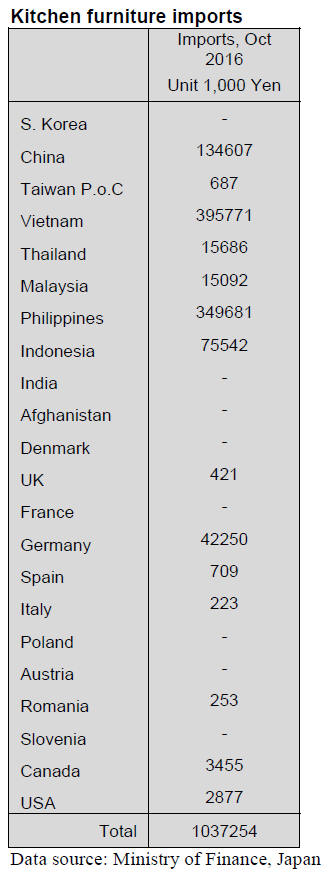
Bedroom furniture imports (HS 940350)
Suppliers in China lead the pack when it comes to Japan¡¯s
imports of wooden bedroom furniture, accounting for over
60% of all Japan¡¯s October 2016 imports of this category
of furniture. Vietnam is the second largest supplier
providing a further 27% of October imports of wooden
bedroom furniture.
The other main suppliers are Thailand and Malaysia
which
provide a combined 8% of imports to Japan. Year on year,
Japan¡¯s October 2016 wooden bedroom furniture fell 12%
with shippers in China bearing most of the decline.
Vietnam saw its share of imports rise in October.

Trade news from the Japan Lumber Reports (JLR)
For the JLR report please see:
http://www.nmokuzai.
com/modules/general/index.php?id=7
Demand and supply projection
The Timber Supply and Demand Conference of Japan,
which is formed by five groups of imported wood
products, came up with the projection of demand for 2017.
Import of logs and lumber from major sources in 2016
increased but they are projected to decrease in 2017.
Housing starts in 2017 are forecasted to drop down to
940,000 units as compared to 970,000 units in 2016.
Therefore the demand for wood would decline in 2017.
Also recent sudden depreciation of the yen would
discourage imports.
In log import, North American would increase but others
like New Zealand, South Sea and Russia continue to
decline. North American log sawmills like Chugoku
Lumber continue stable operations.
Russian log import decrease due to fewer Russian log
cutting sawmills and logs for plywood are replaced by
North American logs and veneer from various sources.
South Sea log import in 2017 is estimated about 100 M
cbms by limited demand for plywood of South Sea logs.
Radiata pine lumber demand for crating would decrease as
the demand is replaced by domestic species.
In lumber, European lumber and North American lumber
would have stable demand. European lumber demand
would increase by about 18%.European lumber business
has been firm because of tight supply. Lumber from North
America has general purpose use so it increased in 2016
with increased housing starts. It will stay almost the same
as 2016.
South Sea (tropical) logs
Log production is down in supplying regions of Sarawak
and Sabah, Malaysia in the middle of rainy season so that
log prices stay up high and local plywood mills struggle to
secure material logs. Sarawak is having heavy rain
particularly and water level of rivers is higher, which
makes towing logs down rivers difficult.
Sarawak meranti log export prices are US$275-278 per
cbm CIF on regular, US$260 on small and US$245 on
super small. Since there are limited number of plywood
mills in Japan using tropical hardwood logs and the
necessary volume is not so much but India needs larger
volume so India is becoming price leader now.
Log production in PNG and Solomon Islands is also
dropping in rainy season but demand is getting low after
China slowed down purchase and India is also taking a
break now so the supply volume seems ample.
Market of keruing and kapur is getting smaller so the
arrival volume is small and the buyers are afraid of losing
money by strong offers so they take wait-and-see attitude.
Plywood
Supply tightness continues on both domestic and imported
plywood. Domestic plywood supply is much tighter in
December than November particularly on thick panels.
Trading companies are trying to jack up the sales prices of
imported plywood, which prices dropped much last year
and future cost would be higher due to weak yen.
November plywood supply was 497,100 cbms, 3.3% more
than November 2015. In this, domestic softwood
production was 250,900 cbms, 8.0% more. High
production of more than 250 M cbms has continued for
three straight months.
The shipment was 252,100 cbms, 3.6% more, which is
higher than the production so the inventory dropped down
to 83,100 cbms.
Large precutting plants placed more orders in December
so supply tightness continues in January but precutting
plants forecast that the orders would slow down in
February so the peak of supply shortage seems to be over
soon.
The market of imported plywood is changing. The prices
are firming on 12 mm panel from Malaysia. The importers
need to increase the sales prices by higher FOB prices by
the suppliers and by sudden weakening of the yen.
Knowing that futures prices would be higher, some try to
secure in the market but nobody has anyinventory.
Supply side is bullish with tight supply of logs in rainy
season. The market prices on concrete forming panel and
structural panel are moving up and further increase may
come if the yen stays weak. Offer prices by Malaysian
suppliers in December of 12 mm concrete forming panel
are US$450 per cbm C&F, US$10 higher than November
and US$510-520 on 3x6 JAS coated concrete forming
panel, US$10 up.
Indonesian suppliers also suffer tight log supply so they
propose higher prices. Present offer prices are US$590-
610 per cbm C&F on floor base overlay better, about
US$750 on 2.4 mm (second class/F4star), about US$610
on 3.7 mm (first class/F4star).
Forestry Agency¡¯s demand projections
The Forest Agency held the wood demand and supply
conference to make forecast of major wood products for
the first half of 2017.
Generally the demand would decline compared to the
same quarter last year but supply of structural laminated
lumber and plywood would increase.
Forecast of housing starts by eleven investigating
organizations indicates 935,000 units in 2017 as compared
to 971,000 units in 2016.
Supply of domestic laminated lumber in the first quarter
would increase by 12.3% by remaining order balance
despite peak of the demand is over. Imported laminated
lumber for the first quarter would increase by 3.4% as
volume of contract in the fourth quarter was high then the
second quarter shows 2.4% less.
European lumber supply would be the same as 2016 with
steady production of lamina and genban in Europe.
Supply of imported plywood for the first quarter would be
5.1% more because the volume contracted in the fourth
quarter would come in from Malaysia and Indonesia then
volume from China and Vietnam would arrive before the
Chinese New Year. The second quarter would be 2%
more.
Demand of domestic softwood plywood has been tight
then demand for non- housing is becoming busy so the
first quarter forecast is 1.4% more than 3.2% more for the
second quarter but supply of domestic logs for plywood
shows 2.4% less for the first quarter and 7.3% less in the
second quarter so raw material supply would become
bottleneck for higher production.
Supply of North American lumber for the first quarter
would increase. Supply of North American logs should be
steady.
Russian lumber supply for the first quarter would be down
by 11.1%.
Radiata pine demand would be down as the demand is
rapidly shifting to domestic species despite promising
forecast of recovery of crating lumber demand by weak
yen, which should encourage export business.
South Sea log import for the first quarter would be down
by temporary reason of closure of lock gate of Niigata
port.
For more see Japan Lumber Reports Jan. 20, 2017 No. 690
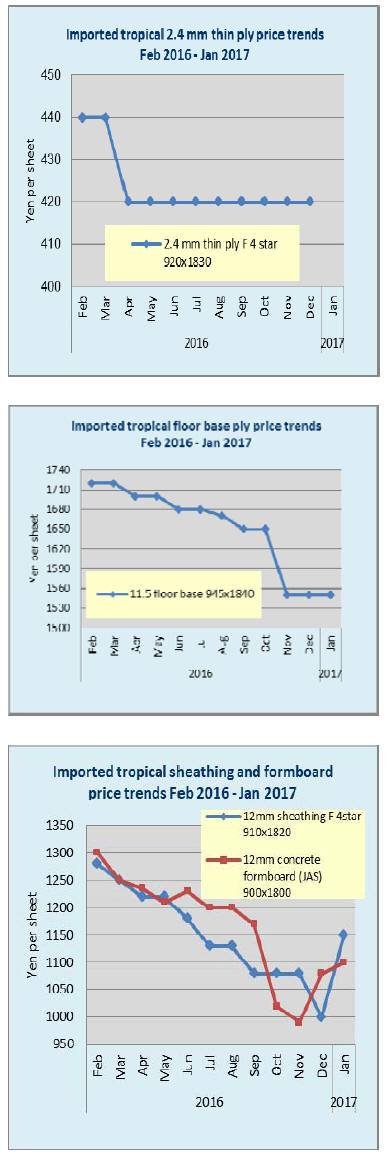
|